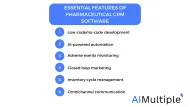Top 7 Computer Vision Use Cases in Healthcare in 2024
Computer vision is a machine’s ability to mimic human vision. As this technology has influenced or even revolutionized almost every industry in the world, healthcare is no expectation. The global market for computer vision solutions in the healthcare sector is projected to significantly grow to $2.4 billion by 2026 from $262 million in 2019.
EY stresses the importance of computer vision and AI technology and considers it crucial to the growth of the healthcare sector.
This article explores computer vision technology in the healthcare sector and some use cases and examples to help guide healthcare professionals towards digital excellence.
What does computer vision mean for the healthcare sector?
Computer vision is used in the healthcare sector to improve medical treatments and procedures, accelerate healthcare research and improve the overall patient experience. It also enables healthcare professionals to make better decisions about patient treatment.
In the healthcare sector, this AI-based technology is used with high-tech cameras and sensors to visualize and extract information that can be used for a variety of applications in healthcare management, treatment, and research.
Computer vision use cases in healthcare
Computer vision and AI have many revolutionary implications in the healthcare sector. Some of them are:
1. Better image analysis
Computer vision has the ability to recognize patterns and make diagnoses in medical images with much higher accuracy and speed and fewer errors. It has the potential to extract information from medical images which are not visible to the human eye.
Additionally, as there is a shortage of radiologists and MRI technicians in the healthcare sector, computer vision can also be considered an effective solution.
2. Detecting tumors and cancers
Computer vision systems can help detect brain tumors with higher speed and accuracy. Additionally, computer vision systems can also be trained through ML and deep learning with data of cancerous and healthy tissues to more accurately detecting skin and breast cancer.
For example, a breast cancer study found it more efficient and accurate than human radiologists. Another study used computer vision and deep learning to create a model that can help in making accurate breast cancer diagnoses through classifying breast ultrasonic images.
Watch how Google has created a cancer-detecting app for skin and breast cancer diagnosis
3. Smart operating facilities
Computer vision can automate the process of recording surgical procedures that involve various repetitive and error-prone tasks. Surgeons forget instruments inside the patient in about 1500 surgeries per year in the US and computer vision can track surgical tools to eliminate this issue.
4. Reduced patient mixup
Patient misidentification is a common issue in the healthcare sector. This can lead to dangerous consequences for the patient and the healthcare provider. A computer vision-enabled face recognition system can eliminate this problem.
5. Increased workplace safety
Surveillance systems enabled through computer vision and AI can monitor the staff for potential incidents and alert relevant authorities when needed. They can also track if the staff uses appropriate safety equipment and procedures.
6. Surgical guidance
Computer vision technology is also used to guide surgeons during procedures by using cameras enabled by machine vision.
7. Better Healthcare research
Computer vision helps accelerate the investigation and testing of new treatments. For example, computer vision systems can perform faster, more accurate, and unbiased cell counting as compared to human workers.
Watch the video to see some real-world examples of computer vision in the healthcare sector
Dedicated annotation tools can provide the level of accuracy and quality required for healthcare/medical annotation tasks.
Check out our sortable and filterable lists of tools and services to compare and choose the best option that fits your annotation requirements:
- Medical Image Annotation Tools list
- Data Annotation / Labelling / Tagging / Classification Service list
Further Reading
If you have further questions please do not hesitate to contact us:



Comments
Your email address will not be published. All fields are required.